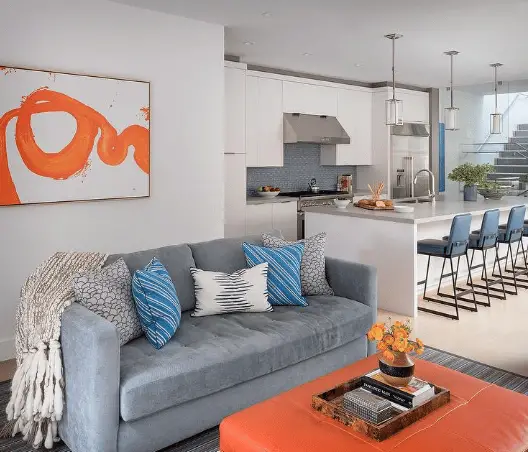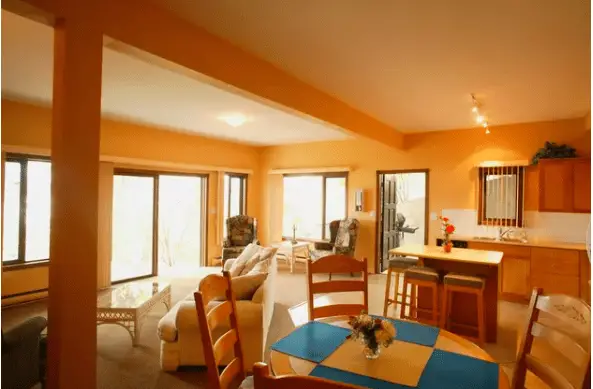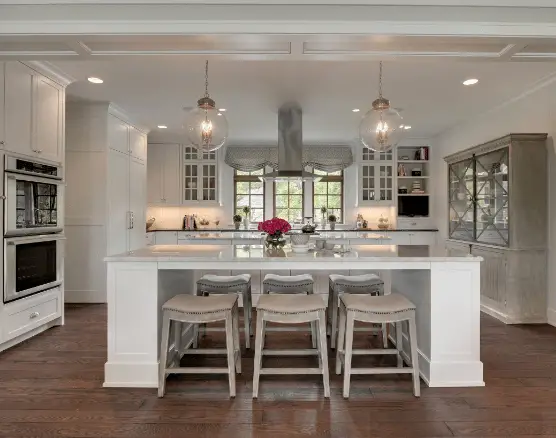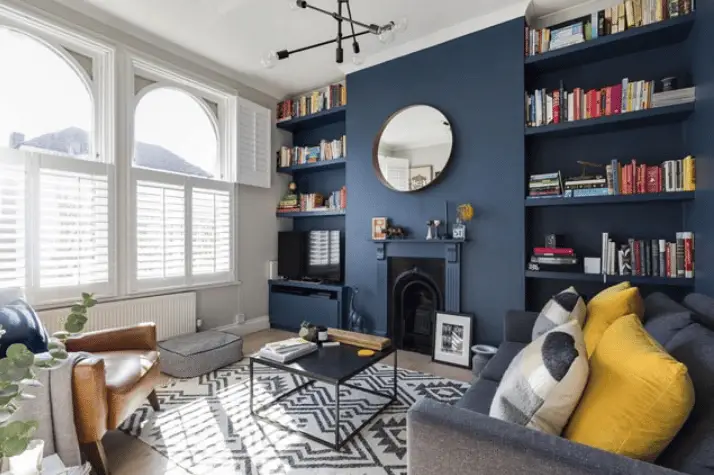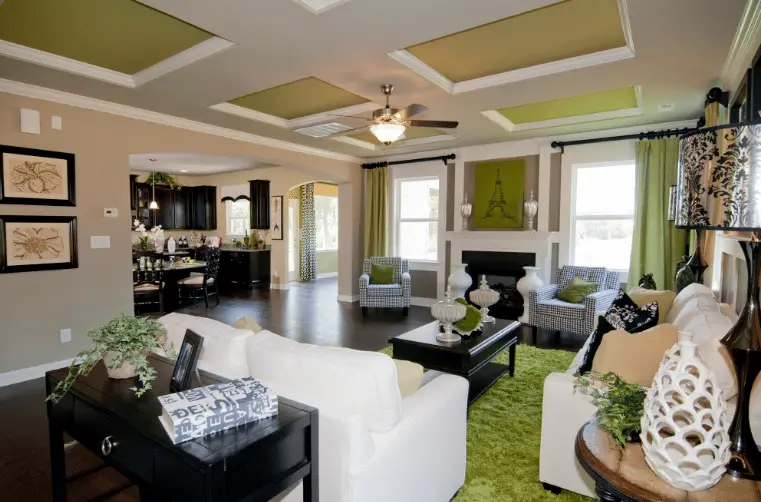You’ve bought a new home, or you’re planning to remodel, but you can’t decide what to do with your living room dining room combo. The color you want for your living room just… doesn’t work for a dining room. Maybe you know what you want in your dining room, but it’s too bland for your living room. Should you paint them two separate colors? These Living Room Dining Room Combo Paint Ideas will answer your questions and kickstart your project!
1) Neutrals
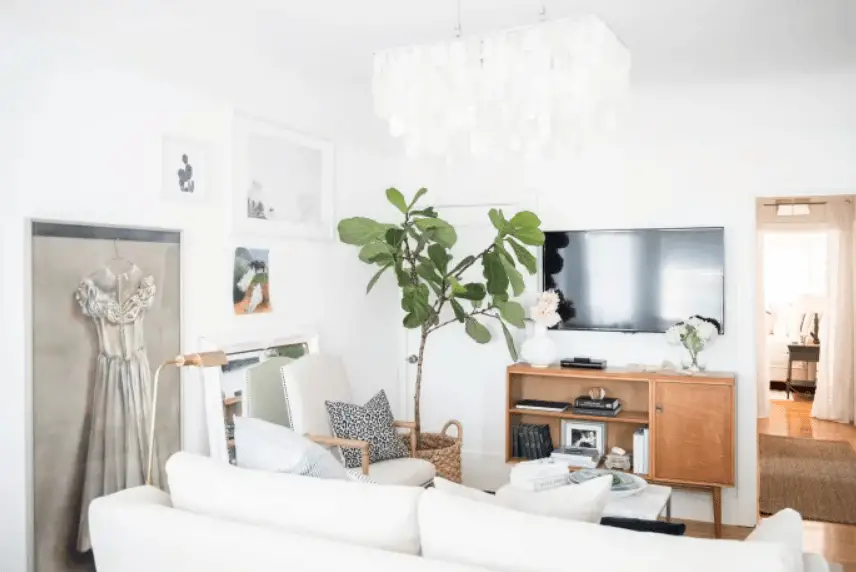
You might be thinking that neutrals are too bland for a living room, but remember that your paint job isn’t everything. Sometimes, when you have two rooms in one, you have to use other types of decoration to give your rooms their unique identities. Typically, you’ll want the same color for the entire room, so your best option is probably to paint it a neutral color like one of the ones in this Apartment Therapy article and then get colorful and unique decorations for each space.
2) Match Colors
You might want some separation to make each space feel unique, but if you’ve used furniture to section off the room, you’ll need to use color to create a cohesive color scheme. That way, the room feels as if it’s tied together even though you have two distinct areas. There are few things more jarring than standing in a pastel blue room and looking at a vibrant orange one. Try picking a couple of colors to carry over from one section to the other to tie the two spaces together visually, just as the designer of this room did.
3) Mural Backdrop
If you want to feel like you have two separate rooms, but you’re stuck with a single room, one way to make them feel separate is to paint an accent for one area and not the other. This separates that space and gives it a unique look. For example, you can paint or commission a mural like the one in this video for your dining room, but leave the living room walls a single, solid color.
4) Sunny

If you had to put your living room and dining room together because you don’t have a lot of space, a small, cramped area could feel depressing. In that case, you’ll want a bright, sunny color like this yellow from Amazon. This would make a lovely wall color, either for an accent wall to highlight your dining set or sitting area, or as the primary color for the entire room. You can also paint furniture yellow to make the room look happier and brighter since yellow is the most joyful color.
5) Pale Green

You can’t comfortably paint the living space and dining area separate colors since they’re in the same room, so what color would work for both? You don’t want something too bold and bright for a dining room; can you imagine eating a steak in a candy pink room? But, a living room should be colorful, sunny, and happy, and even more so if it’s in a smaller space. Pale green paint like this is a good choice for a calming but happy place since green is a natural color that combines calming blue with cheerful yellow.
6) Simple Palette
Combining two rooms into one is already a complicated endeavor, so there’s no reason to make it more complex by using a problematic color palette. Benna Crawford gives some good advice in this article for designing a simple color palette that covers all your needs without creating an unnecessarily involved project. After all, the paint is an integral part of the room, but overthinking it won’t make it any better. If you’re not a designer, then keeping it simple can be your best option.
7) Whitewash

Suppose you’re designing a living room dining room combo because you love the modern, spacious, and airy look. In that case, you’ll want to create a contemporary style using your choice of paint, too. Try starting with a black and white or white and neutral color scheme. For example, if you have any brick, such as a fireplace, a whitewash like this will make it look paler and match the modern look you want. You can paint the walls white or off-white and use black or dark accents for contrast.
8) Red
Red is a bold color, but it looks terrific in either a living room or dining room, so it’s perfect for a living room dining room combo! You can see in this video how the red walls and accent walls add a splash of color to the area. Darker reds are great for dining rooms and work well in living rooms, while bright reds make excellent accent walls. Try combining red walls with dark brown curtains and trim.
9) Texture

You’ll probably want to paint the room all one color, but that doesn’t mean you can’t lend the sitting or dining area a unique look when you paint. Choosing the same color for the whole room but adding texture like this to one section can separate the two spots a bit without making them seem too different or clashing. This will help you achieve the perfect blend of merging the rooms together while recognizing their unique functions.
10) All One Color
If you’ve looked for advice in many places, you’ve probably found one thing to be consistent. You’ll probably want to paint the walls all one color. Well, this isn’t just advice for the walls. You can create an open and consistent look by painting the walls and ceiling all one color, like the walls and ceiling in this room were. You can see how it creates an open and airy look, making for a modern, open-concept space. While the room in the picture is a kitchen and dining area, the same concept applies to any combination room, including yours.
11) Faux Brick

If you’re going for an industrial style with your open look, faux brick is one of the best ways to create that impression. You can roll on a brick pattern and paint it red, either for the whole room or for an accent wall. Consider painting one wall in the living room section to make it feel like you’re in a brick building, and that wall is the only exterior one in this particular room. You can even paint two or three walls and leave one a different color since the faux brick walls will look like exterior walls.
12) Stone Look Wall
It can be hard to find the perfect blend between the comfort of a soft, plush living room and the hard surfaces of a dining room. One thing that works in both rooms is decorative stone. You can paint an accent wall that looks like it’s made of stone in either section of your room or on a shared wall to bring the two spaces together. We thought this tutorial would help you paint a faux stone accent wall or large stone look painting, but you can also hire somebody to make one.
13) Gold

Gold is a bright decoration that people have used as a status symbol in both dining rooms and living rooms for a long time, making it the perfect decoration for a combined living room and dining room. You can use spray paint like this Rust-Oleum from Amazon to spray paint a couple of decorations and place them in different areas in both rooms. This will tie the two rooms together since the shiny gold will reflect light and catch the eye, drawing one’s eye from one piece to the next throughout the room.
14) DIY Accent Wall
An open floor plan like the one for a living room dining room combo can be intimidating. You have so much space and so many ways you can arrange furniture, but no true guide for what the “right” arrangement is. Painting an accent wall can create this guide, but there are even ways to determine the best placement for an accent wall. If you’re feeling lost, this article by Lana from Made In The Shade has excellent advice for an accent wall in an open room.
15) Separate Ceilings
If you have a natural barrier between the two rooms, such as an archway or pillars where a wall would be or where a wall used to be, you can use it to separate the areas slightly while still opening up the room to create a more spacious look. If you have that kind of barrier, one way to make the two sections look distinct but not separate is to paint the ceilings two different colors, provided that there’s a barrier on the ceiling. You can see the incredible effect this has in this Eastwood Homes article.
16) Warm Off-White

Off-whites are your friend in an open room because they reflect light and make the room seem bigger, but unlike pure white, they don’t seem sterile and formal. A warm off-white will create a comforting feeling in your living room and dining room, and it won’t be excessively colorful or feel inappropriate for a dining room. The nice thing about an off-white like this one from Amazon is that you can change your decoration colors, and it’ll still match almost anything.
17) Two Different Colors
If you’re set on using two different colors for your two spaces, but all the advice you’re getting is telling you “no,” we have an idea for doing this. When you watch this video by Rachel Stansfield, you’ll see that she uses a dark green that looks lovely in her living room, but of course, it’d be too dark for a dining area. Her hallway, on the other hand, is painted a different color. She uses the walls’ natural separation to paint them different colors without having any obvious seam, and you can do something similar in your room.
18) Tropical

Since you already have an open room, you can take advantage of that to make it feel airy and sunny, like a vacation home! Tropical paints are designed to create an open, bright, and sunny look that’d cheer anyone up, and if you choose the right one, it’ll match both your living room and dining room. You can try something like this tropical blue since blue can look good in almost any room, and it makes a space feel calming and relaxing.
19) Black Touches

Generally, you’ll want to be careful about using black in interior decorating because it absorbs light and is hard to paint over, but this is one case where black would be wholly appropriate. Open concept rooms are a modern design, so white and black will help you create a modern look. If you have a wide-open space, the black won’t make it look too dark by absorbing light the way it can in a small room. Try using black paint like this for the doors or for the door and window trim.
20) One Wall Color and One Ceiling Color
While painting everything white is probably the easiest way to blend two rooms together, it’s less imaginative than other options. If you’re trying to design something bold and beautiful, you might be skipping the white for a bright and sunny yellow, vibrant orange, natural green, or something similar. If you want to use a lot of color, you can paint all the walls one color and all the ceilings another color. Make sure to paint ceiling beams the same color as the ceiling and archways and wall recesses the same color as the walls, as they did in this room.
21) Bright Green

If you have an open room, or if your room is small and you want it to feel homey and happy instead of cramped, yellow is a good color, but it’s not the only choice. Bright green can create a look that’s just as cheerful as yellow but more unique. Try getting a happy green like this one from Amazon, either as your main color or for an accent wall. Think about whether you’d want an accent wall to highlight the dining room or living room or whether you’d like it to span both to blend them together.
What kind of look are you going for? Did one of our suggestions help you envision the room you want in the end? We’d love to hear your ideas below in the comments.

